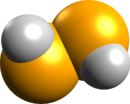二硒化氢
化合物
二硒化氢(英语:Hydrogen diselenide),又称乙硒烷或二硒烷[1],是一种无机硒化合物,其化学式为H2Se2[2],亦可计为(SeH)2,其结构类似于过氧化氢(H2O2)、硫氧化氢(H2SO)与二硫化氢(H2S2),但比前三者更接近90度。用铝还原二氧化硒的盐酸溶液,放出的气体与乙酸铅反应生成的黑色沉淀中含有PbSe₂,证明二硒化氢存在于气体混合物当中。[3]。二硒化氢常温下容易分解为硒化氢(H2Se)和硒单质而无法稳定存在,但可以在一些溶液中存在[3]。二硒化氢可以用在一些有机合成的中间过程[4][5]。
| 二硒化氢 | |||
|---|---|---|---|
| |||
| IUPAC名 Dihydrogen diselenide | |||
| 识别 | |||
| CAS号 | 24765-45-5 | ||
| PubChem | 5248613 | ||
| SMILES |
| ||
| InChI |
| ||
| InChIKey | AVJWYAUVPWRPJX-UHFFFAOYSA-N | ||
| ChEBI | 50476 | ||
| 性质 | |||
| 化学式 | H2Se2 | ||
| 摩尔质量 | 159.94 g·mol−1 | ||
| 外观 | 油状液体 | ||
| 密度 | g cm-3 | ||
| 危险性 | |||
| 闪点 | 易燃 | ||
| 相关物质 | |||
| 相关化学品 | 过氧化氢 硒化氢 二硫化氢 | ||
| 若非注明,所有数据均出自标准状态(25 ℃,100 kPa)下。 | |||
结构
编辑二硒化氢分子的两面角为89.9度,H-Se-Se键角为90.5度,H-Se键长为1.536埃,Se-Se键长为2.380埃。二硒化氢扭转运动电势能垒高度与硫氧化氢类似,而扭转穿隧的分解则与二硫化氢有相同的观测值[6]。此外,二硒化氢和二碲化氢(hydrogen ditelluride)[7]的分子结构都有转动屏障的现象。[8]
结构类似的化合物
编辑还有一些硒化合物的结构类似过氧化氢,如硒氧化氢、硒硫化氢,但他们都不稳定。
参考文献
编辑- ^ 化學命名原則 (PDF). 国立编译馆. 2011-04-01 [2016-02-27]. (原始内容存档 (PDF)于2016-03-22).
- ^ Macintyre, J.E. Dictionary of Inorganic Compounds. Taylor & Francis. 1992: 293. ISBN 9780412301209.
- ^ 3.0 3.1 Shaw, B.L. and Stavely, L.A.K. Inorganic Hydrides: The Commonwealth and International Library: Chemistry Division. Commonwealth and international library: Chemistry division. Elsevier Science. 2013: 76. ISBN 9781483160320.
- ^ Craig A. Bayse and Andrea Pavlou. Tuning the activity of glutathione peroxidase mimics through intramolecular Se⋯N,O interactions: A DFT study incorporating solvent-assisted proton exchange (SAPE), 9. Org. Biomol. Chem.: 8006. 2011-05-25. doi:10.1039/c1ob05827d.
- ^ Dinesh R. Garud, Masaki Makimuraa and Mamoru Koketsu. Dinesh R. GarudCurrent address: Department of Chemistry, Sir Parashurambhau College, Tilak road, Pune 411030. India., Masaki Makimura and Mamoru Koketsu. Synthetic approaches to selenacephams and selenacephems via a cleavage of diselenide and selenium anion 35. New J. Chem.: 581. 2010-10-12. doi:10.1039/c0nj00782j.
|year=与|date=不匹配 (帮助); - ^ Gottselig, Michael; Quack, Martin; Willeke, Martin. Mode-selective stereomutation tunneling as compared to parity violation in hydrogen diselenide isotopomers1,2,3H280Se2. Israel Journal of Chemistry (Wiley-Blackwell). 2003, 43 (3-4): 353–362. ISSN 0021-2148. doi:10.1560/1khd-g0yt-3yeu-n16p.
- ^ Cornelis E. C. A. Hop, Marco A. Medina. H2Te2 Is Stable in the Gas Phase 116 (7). J. Am. Chem. Soc.: pp 3163–3164. April 1994. doi:10.1021/ja00086a072.
- ^ Ewig, Carl S.; Mei, Elizabeth H.; Van Wazer, John R. Rotational barriers in H2Se2and H2Te2. Molecular Physics (Informa UK Limited). 1980, 40 (1): 241–245. ISSN 0026-8976. doi:10.1080/00268978000101431.
- Héctor García-Marín, John C. van der Toorn, José A. Mayoral, José I. García and Isabel W. C. E. Arends. Glycerol-based solvents as green reaction media in epoxidations with hydrogen peroxide catalysed by bis[3,5-bis(trifluoromethyl)-diphenyl] diselenide, Green Chem., 2009, 11, 1605.doi:10.1039/b913052g
- Charlotte Gabel-Jensen, Kristoffer Lunøe and Bente Gammelgaard. Formation of methylselenol, dimethylselenide and dimethyldiselenide in in vitro metabolism models determined by headspace GC-MS, Metallomics, 2010, 2, 167.doi:10.1039/b914255j
- Wei-Wei Xiong, Jian-Rong Li, Mei-Ling Feng and Xiao-Ying Huang. Solvothermal syntheses, crystal structures, and characterizations of a series of one-dimensional organic-containing gallium polyselenides, CrystEngComm, 2011, 13, 6206.doi:10.1039/c1ce05507k
- Xin Huang, Xiaoman Liu, Quan Luo, Junqiu Liu and Jiacong Shen. Artificial selenoenzymes: Designed and redesigned, Chem. Soc. Rev., 2011, 40, 1171.doi:10.1039/c0cs00046a

